




Evolution of Earth's Atmosphere
Decoding Archean atmosphere based on wevelength-dependent isotope effect
The redox evolution of the Earth's atmosphere is key to understanding the early evolution of the biosphere, though the chemical composition of Earth's early atmosphere is still poorly constrained. The Sulfur Mass Independent Fractionation (S-MIF) in sedimentary rocks can be a useful tracer for understanding chemistry of the anoxic atmosphere, though the mechanisms and factors controlling the S-MIF signal have been poorly understand yet. Based on laboratory experiments of photolysis and photo-excitation reactions, we have studied fundamental mechanism of the MIF-yielding photochemical processes. Also, we have determined higher resolution UV absorption cross sections of SO2 isotopologues (Danielache et al., 2008; 2012; Endo et al., 2016). These results indicate the wavelength of the UV is a key to understand the link between atmospheric chemistry and the MIF signal (Endo et al., 2017; Mishima et al., 2017; Ueno et al., 2015). We have tried to use the wavelength-dependency of the isotopic fractionation to uncover the chemical evolution of Earth's early atmosphere.

Photochemical reaction chamber for simulating anoxic atmosphere. / Estimated UV spectra of early Earth.
Geological distribution of mass-independently fractionated sulfur isotopes
Recent discovery of sulfur mass-independent fractionation (MIF) in pre-2.3 Ga sedimentary rocks provided new insights into the Earth's early sulfur cycle (Farquhar et al. 2000). The anomaly had been produced by the photochemical reactions under the oxygen-poor Early atmosphere. One of the most fundamental and unsolved questions is how the atmospheric signature has been preserved in the rock record. In order to understand the processes of preservation, we must investigate geological and petrographical distributions and variations of the 33S and 36S anomalies. We have analyzed wide range of Archean sulfides, which are well characterized by detailed field mappings and petrographic observations.

Euhedral pyrites separated from Archean chert.
Stable Isotope Geochemistry
Carbon isotope analyses of methane in fluid inclusions
We have developed a system for extracting tiny amount of methane preserved within ancient quartz minerals as a fluid inclusion, and determining carbon isotopic composition. The analysis of a 3.5 Ga deposit demonstrated the presence of 13C-depleted methane. The result indicates methanogen (i.e. methane producing microbe) were active and important for the Archean surface environment (Ueno et al., 2006; 2007).

Methane-bearing fluid inclusion in 3.5 Ga hydrothermal deposit from Western Australia.
Geological distribution of the Archean 13C-depleted kerogen
Archean sedimentary rocks usually contain 13C-depleted kerogen, which were probably produced by ancient micro-organisms. Geological distributions of such kerogens are important for the better understanding of the early biosphere. I have joined Pilbara field mapping project of the Titech group headed by S. Maruyama, and have revealed that the Archean hydrothermal veins generally contain considerable amount of 13C-depleted kerogen relative to surrounding sedimentary rocks (Ueno et al., 2004). This may suggest that the Archean sub-seafloor hydrothermal system was the habitat of the early organisms.

Synsedimentary veins developed in a 3.5 Ga oceanic crust.
The Dresser Fm., Western Australia.
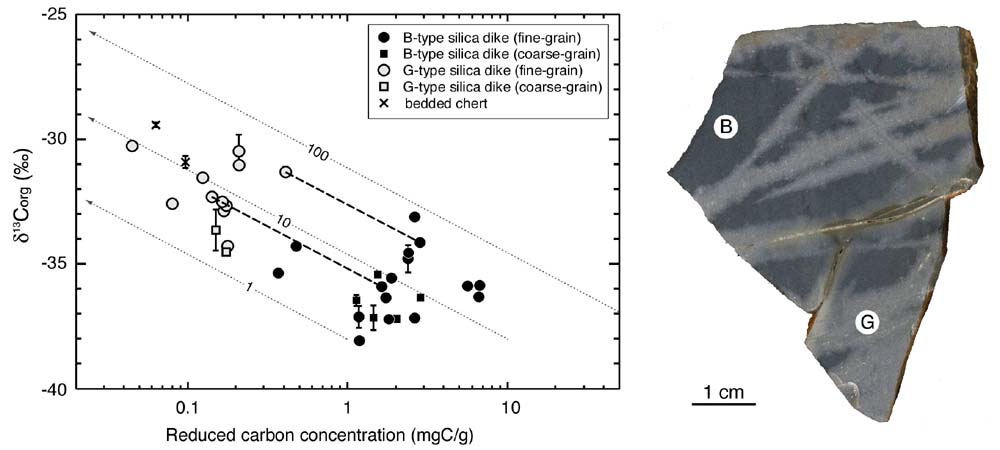
C-isotopic compositions of kerogens in the hydrothermal silica veins.
Lithology-dependent isotopic variation suggests post-depositional 13C-enrichment.
Ion-microprobe analyses of graphite and kerogen
Carbon isotopic compositions of micron-scale organic matter including microfossils have potential to constrain the carbon fixation pathway utilized by the past autotrophs. The ion microprobe (SIMS) can differentiate the isotopic variability at a scale of <5 µm with <3 ‰ precision (Ueno et al., 2001). The application of the in-situ analyses for the 3.8 Ga Isua graphite has also revealed that the graphite had been originally more 13C-depleted isotopic composition before metamorphic event (Ueno et al., 2002).

Graphite-bearing garnet in a ~3.8 Ga metasediment from the Isua Greenstone Belt.
Pc/C boundary drilling project: Irreversible change of Earth's biogeochemical cycling
Multicellular animals first appeared in the Neoproterozoic and their morphological diversity was rapidly increased by the Early Cambrian. This biological evolution may have fundamentally changed oceanic biogeochemical cycling. We have performed chemostratigraphic analysis from the entire Ediacaran to Early Cambrian by using drill core samples from the Yangtze Platform, South China. The link between C/N/S cycling and animal evolution is a key to understand biogeochemical cycling in the Earth's ocean.
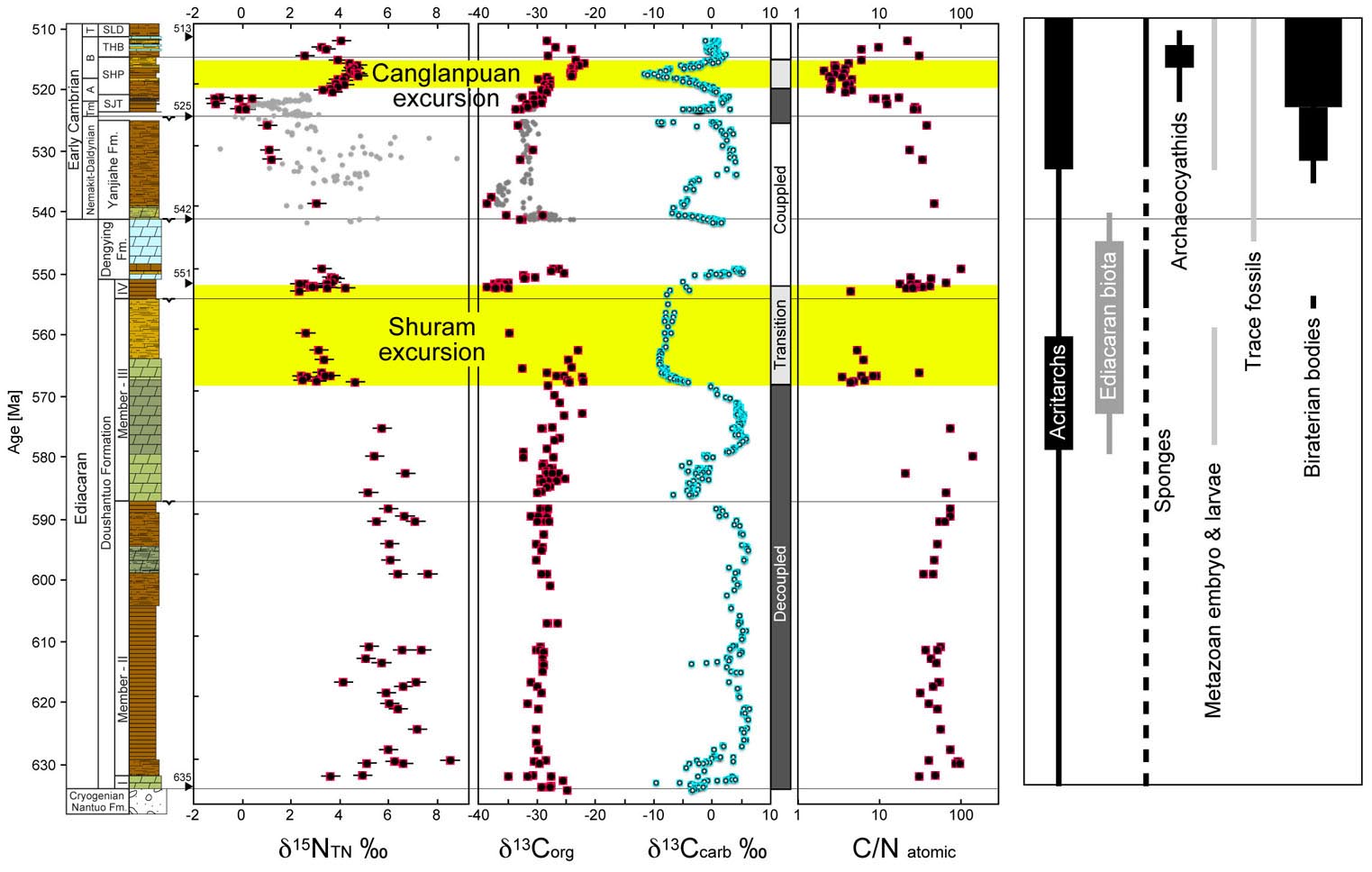
Chemostratigraphy of the drill core tells transition of C and N cycling in the ocean from Ediacaran to Cambrian (Kikumoto et al., 2014).
Archean Geology
The ~3.5 Ga North Pole area, Pilbara craton, Western Australia
I have joined field mappings of Pilbara craton by the Titech group since 1996. My field research has focused on the North Pole area at the central part of Pilbara Granite-Greenstone Terrane. The area is well-known as a locality of the oldest (~3.5 Ga) microfossils (Awramik et al., 1983). Our intensive field mapping has demonstrated the fossil-bearing chert/barite beds are closely associated with synsedimentary hydrothermal veins (silica veins), which penetrated into >1000 m-thick pillowed basaltic greenstones below the chert/barite bed (e.g., Isozaki et al., 1997; Kitajima et al., 2001). This greenstone/chert sequence occurs as a tectonic slice bounded by layer-parallel thrust. The stacking pattern of the tectonic slices shows duplex structure produced by horizontal shortening. This suggests that the greenstone/chert sequences represent fragments of the Archean oceanic crust accreted into the arc or continent at subduction zone (e.g., Maruyama et al., 1991).

Dusk in the North Pole area, Pilbara craton, Western Australia.

Horizontal-shortening structure observed in the North Pole area (Ueno 2002 Doctor Thesis). Thrust-bounded tectonic slices composed of pillowed basalt and overlying chert bed are repeated nine times and form imbricated thrust piles (duplex structure).
The 2.8 to 2.6 Ga Fortescue Group, Western Australia
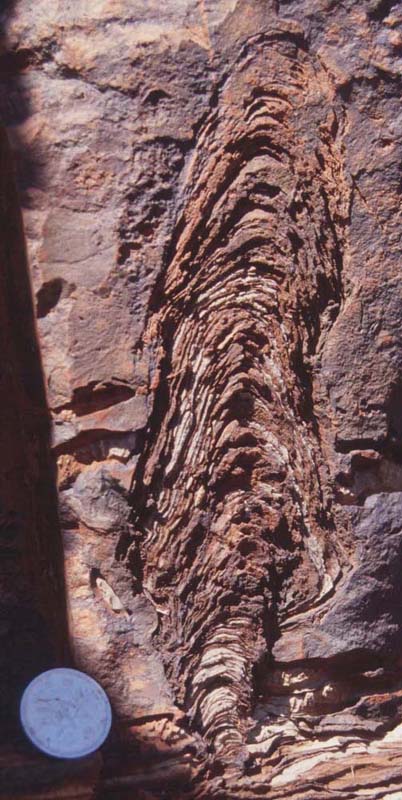 The ~2.7 Ga Tumbiana Formation of the Fortescue Group is a succession developed in response to Late Archean crustal extension in the Pilbara Craton, northwestern Australia. The formation is characterized by the wide occurrence of oxygenic stromatolites (Buick 1992), and provides a perspective of the evolution of photosynthetic organisms, which are interpreted to have been responsible for the oxygenation of ocean and atmosphere in early Earth.
The ~2.7 Ga Tumbiana Formation of the Fortescue Group is a succession developed in response to Late Archean crustal extension in the Pilbara Craton, northwestern Australia. The formation is characterized by the wide occurrence of oxygenic stromatolites (Buick 1992), and provides a perspective of the evolution of photosynthetic organisms, which are interpreted to have been responsible for the oxygenation of ocean and atmosphere in early Earth.  In collaboration with Prof. Makoto Ito at Chiba University, we have performed detailed field mapping and sequence-stratigraphic analyses of the Tumbiana Formation in the Redmont area, a central part of the Pilbara Craton (Sakurai et al., 2005).
In collaboration with Prof. Makoto Ito at Chiba University, we have performed detailed field mapping and sequence-stratigraphic analyses of the Tumbiana Formation in the Redmont area, a central part of the Pilbara Craton (Sakurai et al., 2005).
Also, the sedimentary rocks of the Fortescue Group host anomalously 13C-depleted kerogen (up to -60 permil;. It has been hypothesized that the onset of oxygen release resulted in the appearance of O2-dependent methanotrophy, which would have produced the extremely 13C-depleted organic matter (Hayes 1994). For the better understanding of the biological activity and at that time and evaluating the effect of photosynthesis on surrounding environment, we have investigated geological, stratigraphical, and petrographical distributions of the 13C-depleted kerogen (Sakurai, 2003).

A model of spatial and temporal variations in depositional systems of
the Tumbiana Formation in the Redmont area (Sakurai et al., 2005).
Search for Late Archean ice ages
Late Archean volcanosedimentary sequences occur in Dharwar Craton, south India. Since 2010, we have conducted field study and geochemistry of Dharwar Supergroup for understanding how unique the Late Archean environment. Our chronological work indicate the sequences were deposited from 2.9 to 2.4 Ga (Hokada et al., 2013) that include stromatolitic carbonates, Mn-rich iron formations and clastics rocks including diamictite.
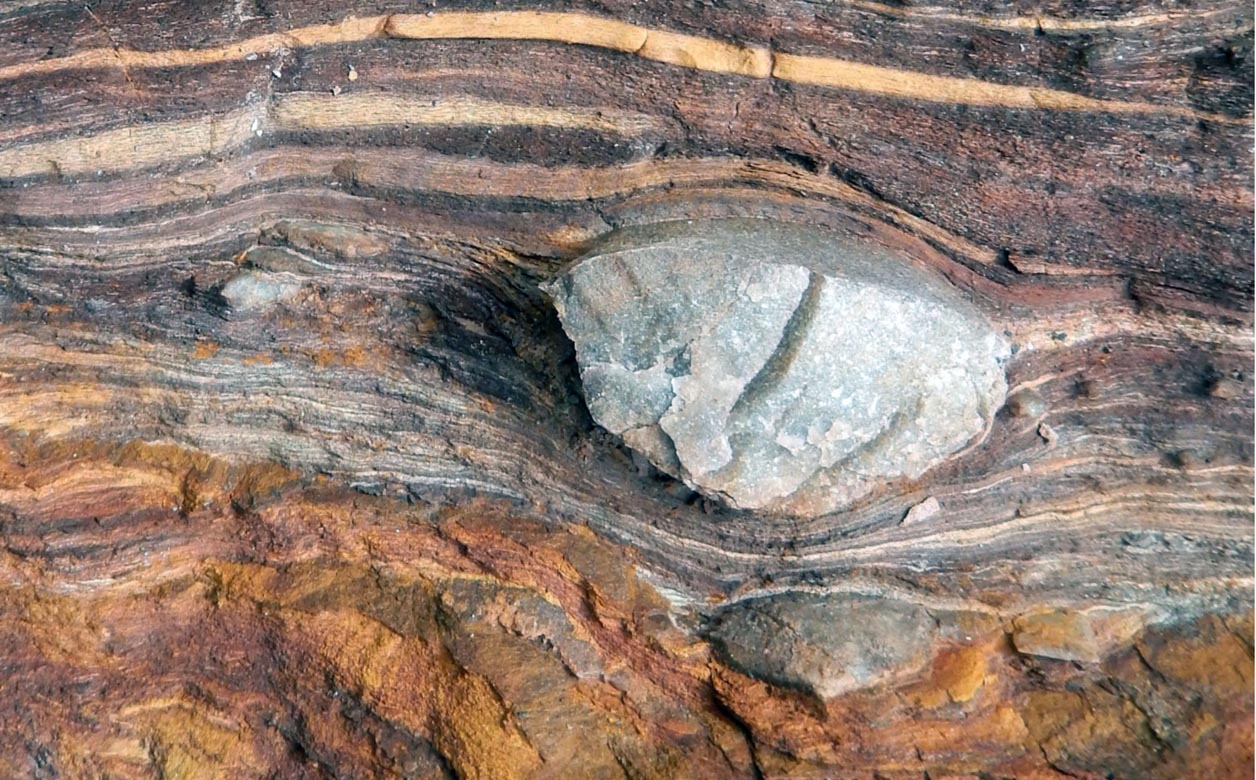
Pre-2.7 Ga diamictite in the Late Archean Dharwar Supergroup.
The ~4.0 Ga Acasta Gneiss Complex, Slave craton, Canada
Ancient crustal rocks provide the only direct evidence for surface tectonics, and the processes and products of differentiation in early Earth. However, the oldest recognized terrestrial rocks (≧3600 Ma) are rare, and only nine terrains are preserved. The Acasta Gneiss Complex contains the 4.03 Ga orthogneisses (Bowring & Williams, 1999), which are the oldest rocks in the world so far.
We have reinvestigated geology and geochronology of the Acasta Gneiss Complex in Slave Province, Northwest Territories of Canada. Based on detailed 1:5000 scale geological mapping and petrographic investigation of about 1000 specimen, we have documented six distinct lithofacies, and at least eight tectonothermal events (Iizuka et al., 2007). Our research has focused on searching for information of the earliest surface environment through the study of multiple sulfur isotopes.
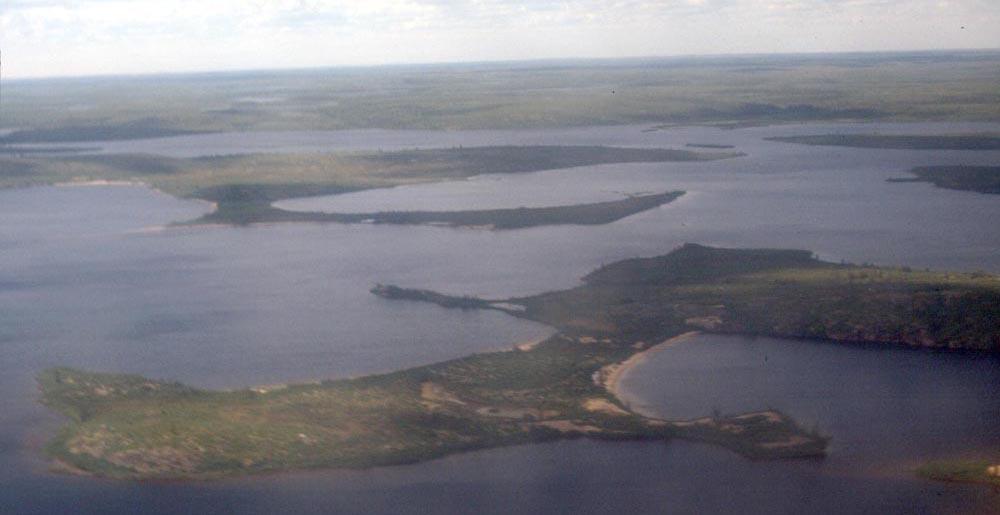
Acasta River.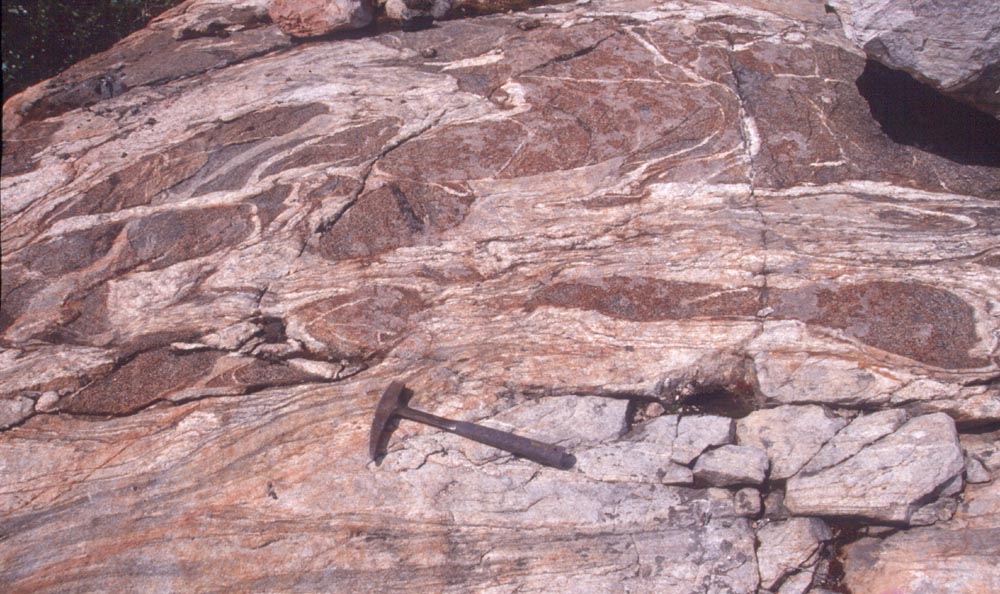
About 4.0-billion-years-old orthogneisses and older enclaves of mafic rock. 
Midnight rainbow from camp site.
Micro-paleontology
Chemistry of prokaryotic fossils
The most direct evidence for the Precambrian life is morphologically preserved microfossils. However, the firm criteria for biogenicity of Archean microfossils have not yet been established. We are trying to extract molecular and isotopic information from the organic-walled fossils and carbonaceous material (kerogen) by using Ion microprobe, IR- and Raman-spectroscopy.
Origins of Life
It is still highly uncertain where and how the geochemical processes was transformed into biological system. Before origin of life, organic molecules (i.e. life's building blocks) should have been supplied constantly on the prebiotic Earth. We have speculated that a simple geochemical system originally produced several specific carboxylic acids on the Hadean Earth and then evolved into more complex system step by step. In our group, we focus on UV chemistry of reducing atmosphere and ocean for driving the "proto-metabolism".
For understanding Earth's early environment, we can learn many things from "strange" hot spring. In Hakuba Happo hot spring ("ONSEN" in Japanese), unusually alkaline and H2-rich fluid came from bore hole located in a serpentinite body. The serpentinite is a rock produced by interaction between water and ultramafic rock that is thought to have been widespread on the Hadean seafloor. Through the field study and geochemistry, we are trying to understand how the serpentinization process makes H2, CH4 and organic compounds (Suda et al., 2014; 2017) and what types of microbial ecosystem can be inhabited in the environment analogous to early Earth's seafloor.

Cyanobacterial microfossils (samples kindly provided by Prof. S. Awramik)
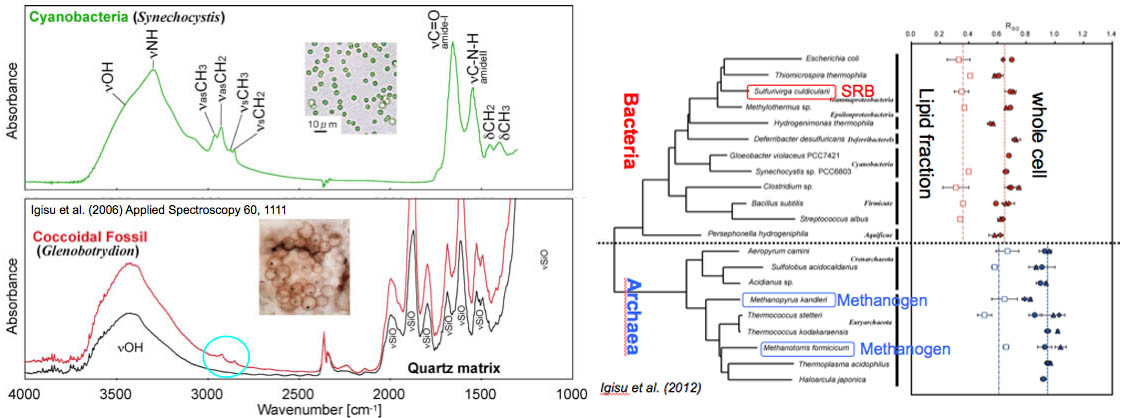
IR-spectra of modern and fossilized cyanobacteria. The IR signature has been used for distinguish Archaea and Bacteria (Igisu et al., 2006; 2012).
UV-driven proto-metabolism on Hadean Earth
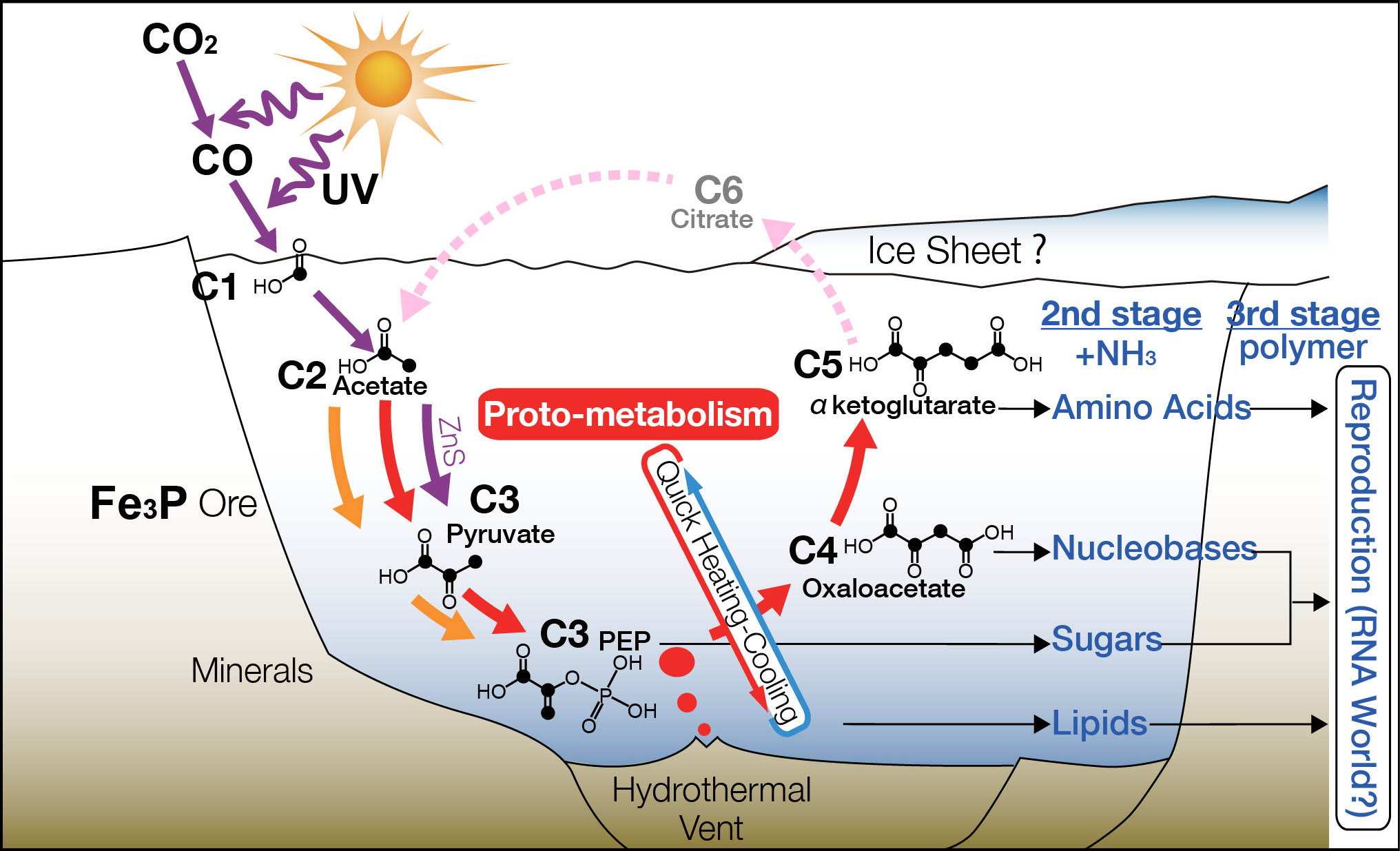
Working hypothesis of proto-metabolism
ONSEN (hot spring) project
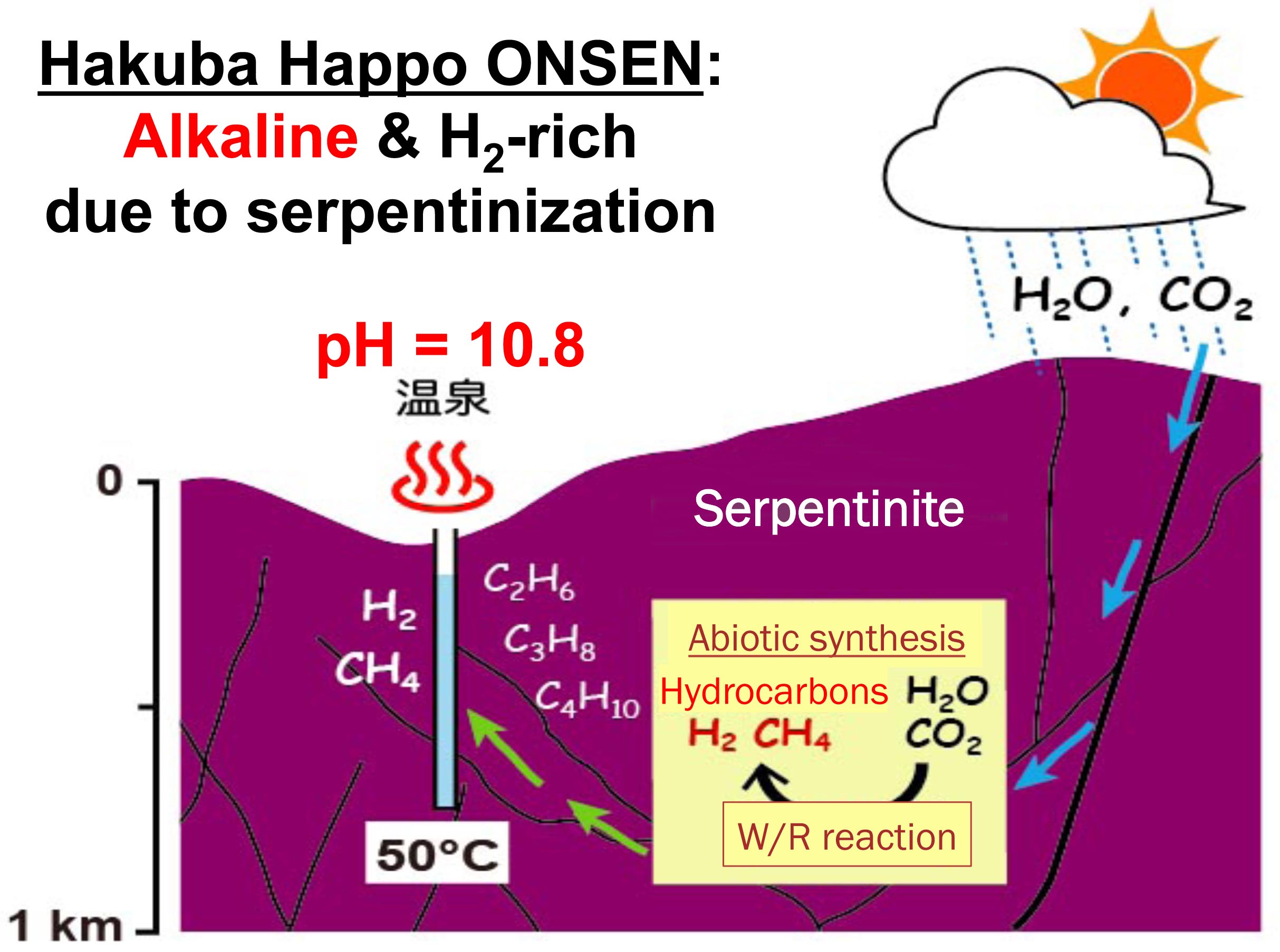
ONSEN project led by ELSI researchers, Profs. Kurokawa, Maruyama and Yoshida.